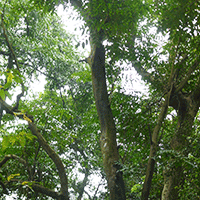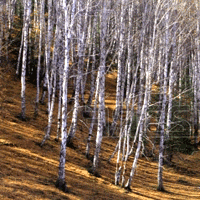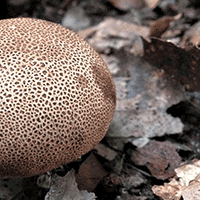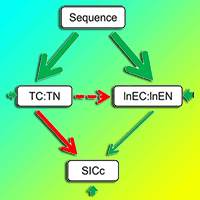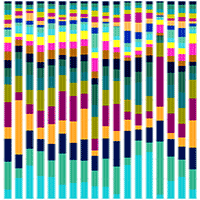Soil microbes play a key role in the formation and decomposition of organic materials and in the improvement of the ecological environment. Despite continuous increases in nitrogen (N) and phosphorus (P) inputs due to the atmospheric deposition or fertilization, the response of soil to exogenous inorganic nutrients inputs remains elusive. By a manipulative experiment we simulated N and P depositions in a subtropical secondary Castanopsis sclerophylla forest in east China over the period 2011-2015, to evaluate the impact of inorganic nutrient addition on soil bacterial communities. Four treatments were administered (control and nutrient-enrichment: N, P, and N+P), with N added at a total of 100 kg N ha-1 yr-1 in the form of NH4NO3, and P at 50 kg P ha-1 yr-1 in Ca(H2PO4)2, sprayed near the soil surface at the end of each trimester. Quantitative PCR technique and Illumina platform-based sequencing analysis of the V3-V4 16S rRNA gene region were performed on total DNA extracted from soil samples to characterize the soil bacterial community abundance and diversity. As Proteobacteria, Acidobacteria and Actinobacteria were the predominant phyla in all conditions, treatments did not alter the distribution of bacterial phyla, while their relative abundances responded differently to N, P additions. A GLMM analysis showed that N input significantly (P < 0.05) reduced the relative abundance of Acidobacteria (13.11%), Bacteroidetes (0.6%), Elusimicrobia (0.21%), Nitrospirae (0.1%) and TM6 (0.04%). Relative abundance after P treatment significantly (P < 0.01) decreased for Nitrospirae (0.07%), and pronounced interactive effects of N and P additions (N:P) were observed on phylum Nitrospirae (P < 0.01) and TM6 (P < 0.05). Moreover, redundancy analysis revealed that soil pH was closely related to the bacterial community (r2 = 0.622, P = 0.015). Our findings suggest that exogenous N and P inputs affected the relative abundances and caused compositional shifts in the local bacterial community that closely associated with soil pH, thus providing the evidence that microbe-soil interactions are influenced by N and P availability in subtropical forest ecosystem of east China.
Keywords
, , , ,
Citation
Teng Z, Cui J, Wang J, Fu X, Xu X (2018). Effect of exogenous nitrogen and phosphorus inputs on the microbe-soil interaction in the secondary Castanopsis sclerophylla forest in east China. iForest 11: 794-801. - doi: 10.3832/ifor2673-011
Academic Editor
Giorgio Alberti
Paper history
Received: Nov 02, 2017
Accepted: Oct 16, 2018
First online: Dec 14, 2018
Publication Date: Dec 31, 2018
Publication Time: 1.97 months
© SISEF - The Italian Society of Silviculture and Forest Ecology 2018
Open Access
This article is distributed under the terms of the Creative Commons Attribution-Non Commercial 4.0 International (https://creativecommons.org/licenses/by-nc/4.0/), which permits unrestricted use, distribution, and reproduction in any medium, provided you give appropriate credit to the original author(s) and the source, provide a link to the Creative Commons license, and indicate if changes were made.

Breakdown by View Type
(Waiting for server response...)
Article Usage
Total Article Views: 45519
(from publication date up to now)
Breakdown by View Type
HTML Page Views: 37544
Abstract Page Views: 3807
PDF Downloads: 3213
Citation/Reference Downloads: 14
XML Downloads: 941
Web Metrics
Days since publication: 2576
Overall contacts: 45519
Avg. contacts per week: 123.69
Article Citations
Article citations are based on data periodically collected from the Clarivate Web of Science web site
(last update: Mar 2025)
Total number of cites (since 2018): 8
Average cites per year: 1.00
Publication Metrics
by Dimensions ©
Articles citing this article
List of the papers citing this article based on CrossRef Cited-by.
(1)
Aber J, McDowell WH, Nadelhoffer K, Magill A, Berntson G, Kamakea M, McNulty SG, Currie WS, Rustad L, Fernandez IJ (1998)Nitrogen saturation in temperate forests ecosystems. Bioscience 48 (11): 921-934.
CrossRef |
Gscholar
(2)
Barker H (1949)Soil bacteria: useful in studying processes of organic matter formation and decomposition. California Agriculture 3 (1): 10-10.
Online |
Gscholar
(3)
Barns SM, Takala SL, Kuske CR (1999)Wide distribution and diversity of members of the bacterial kingdom Acidobacterium in the environment. Applied and Environmental Microbiology 65 (4): 1731-1737.
Online |
Gscholar
(4)
Bates D, Maechler M (2009)lme4: linear mixed-effects models using S4 classes. R package version 0:999375-32.
Online |
Gscholar
(5)
Bucbe M, Reich M, Murat C, Morin E, Nilsson RH, Uroz S, Martin F (2009)454 pyrosequencing analyses of forest soils reveal an unexpected high fungal diversity. New Phytologist 184 (2): 449-456.
CrossRef |
Gscholar
(6)
Caporaso JG, Kuczynski J, Stombaugh J, Bittinger K, Bushman FD, Costello EK, Fierer N, Peña AG, Goodrich JK, Gordon JI (2010)QIIME allows analysis of high-throughput community sequencing data. Nature Methods 7 (5): 335-336.
CrossRef |
Gscholar
(7)
Chan OC, Yang X, Fu Y, Feng Z, Sha L, Casper P, Zou XM (2010)16S rRNA gene analyses of bacterial community structures in the soils of evergreen broad-leaved forests in south-west China. Fems Microbiology Ecology 58 (2): 247-259.
CrossRef |
Gscholar
(8)
Chao A (1984)Non-parametric estimation of the classes in a population. Scandinavian Journal of Statistics 11 (4): 265-270.
Gscholar
(9)
Cui J, Wang J, Xu J, Xu C, Xu XN (2017)Changes in soil bacterial communities in an evergreen broad-leaved forest in east China following 4 years of nitrogen addition. Journal of Soils and Sediments 17 (8): 2156-2164.
CrossRef |
Gscholar
(10)
De Vries W, Reinds GJ, Gundersen P, Sterba H (2006)The impact of nitrogen deposition on carbon sequestration by European forests and heathlands. Global Change Biology 12 (7): 1151-1173.
CrossRef |
Gscholar
(11)
Euzéby JP (1997)List of bacterial names with standing in nomenclature: a folder available on the internet. International Journal of Systematic Bacteriology 47 (2): 590-592.
CrossRef |
Gscholar
(12)
Fierer N, Bradford MA, Jackson RB (2007)Toward an ecological classification of soil bacteria. Ecology 88 (6): 1354-1364.
CrossRef |
Gscholar
(13)
Freedman Z, Eisenlord SD, Zak DR, Xue K, He Z, Zhou J (2013)Towards a molecular understanding of N cycling in northern hardwood forests under future rates of N deposition. Soil Biology and Biochemistry 66 (11): 130-138.
CrossRef |
Gscholar
(14)
Galloway JN, Townsend AR, Erisman JW, Bekunda M, Cai Z, Freney JR, Martinelli LA, Seitzinger SP, Sutton MA (2008)Transformation of the nitrogen cycle: recent trends, questions, and potential solutions. Science 320 (5878): 889-892.
CrossRef |
Gscholar
(15)
Glick BR, Patten CL, Holguin G, Penrose DM (1999)Nitrogen fixation: biochemical and genetic mechanisms used by plant growth promoting bacteria. Imperial College Press, London, UK, pp. 14-44.
Gscholar
(16)
Grayston SJ, Prescott CE (2005)Microbial communities in forest floors under four tree species in coastal British Columbia. Soil Biology and Biochemistry 37 (6): 1157-1167.
CrossRef |
Gscholar
(17)
Gu FX, Zhang YD, Huang M, Tao B, Yan HM, Guo R, Li J (2015)Nitrogen deposition and its effect on carbon storage in Chinese forests during 1981-2010. Atmospheric Environment 123 (1): 171-179.
CrossRef |
Gscholar
(18)
Han W, Fang J, Guo D, Zhang Y (2005)Leaf nitrogen and phosphorus stoichiometry across 753 terrestrial plant species in China. New Phytologist 168 (2): 377-385.
CrossRef |
Gscholar
(19)
He N, Zhu J, Wang Q (2015)Uncertainty and perspectives in studies of atmospheric nitrogen deposition in China: a response to Liu et al. (2015). Science of The Total Environment 520: 302-304.
CrossRef |
Gscholar
(20)
Ho A, Di LD, Bodelier PL (2017)Revisiting life strategy concepts in environmental microbial ecology. FEMS Microbiology Ecology 93 (3): fix006.
CrossRef |
Gscholar
(21)
Janssen PH (2006)Identifying the dominant soil bacterial taxa in libraries of 16S rRNA and 16S rRNA genes. Applied and Environmental Microbiology 72 (3): 1719-1728.
CrossRef |
Gscholar
(22)
Jenkinson DS (1988)Determination of microbial biomass carbon and nitrogen in soil. In: “Advances in Nitrogen Cycling in Agricultural Ecosystems” (Wilson JR eds). CAB International, Wallingford, UK, pp. 368-386.
Gscholar
(23)
Jesmok EM, Hopkins JM, Foran DR (2016)Next-generation sequencing of the bacterial 16s rRNA gene for forensic soil comparison: a feasibility study. Journal of Forensic Sciences 61 (3): 607-617.
CrossRef |
Gscholar
(24)
Jones D, Willett V (2006)Experimental evaluation of methods to quantify dissolved organic nitrogen (DON) and dissolved organic carbon (DOC) in soil. Soil Biology and Biochemistry 38 (5): 991-999.
CrossRef |
Gscholar
(25)
Jones RT, Robeson MS, Lauber CL, Hamady M, Knight R, Fierer N (2009)A comprehensive survey of soil acidobacterial diversity using pyrosequencing and clone library analyses. ISME Journal 3 (4): 442-453.
CrossRef |
Gscholar
(26)
Kolbert CP, Persing DH (1999)Ribosomal DNA sequencing as a tool for identification of bacterial pathogens. Current Opinion in Microbiology 2 (3): 299-305.
CrossRef |
Gscholar
(27)
Leff JW, Jones SE, Prober SM, Barberán A, Borer ET, Firn JL (2015)Consistent responses of soil microbial communities to elevated nutrient inputs in grasslands across the globe. Proceedings of the National Academy of Sciences USA 112 (35): 10967-10972.
CrossRef |
Gscholar
(28)
Leveau JHJ, Uroz S, Boer WD (2010)The bacterial genus
Collimonas: mycophagy, weathering and other adaptive solutions to life in oligotrophic soil environments. Environmental Microbiology 12 (2): 281-292.
CrossRef |
Gscholar
(29)
Li Y, Niu S, Yu G (2016a)Aggravated phosphorus limitation on biomass production under increasing N addition: a meta-analysis. Global Change Biology 22 (2): 934-943.
CrossRef |
Gscholar
(30)
Li M, Xu J, Tian D, Yu X, Xu XN (2016b)Effect of nitrogen and phosphorus addition on litterfall production and nutrient dynamics in a
Castanopsis sclerophylla secondary forest. Chinese Agricultural Science Bulletin 32 (19): 7-13. [in Chinese with English abstract]
Gscholar
(31)
Loman NJ, Misra RV, Dallman TJ, Constantinidou C, Gharbia SE, Wain J (2012)Performance comparison of benchtop high-throughput sequencing platforms. Nature Biotechnology 30 (5): 434-439.
CrossRef |
Gscholar
(32)
Lu J, Domingo JWS, Hill S, Edge TA (2009)Microbial diversity and host. Applied and Environmental Microbiology 75 (18): 5919-5926.
CrossRef |
Gscholar
(33)
Lu X, Mao Q, Gilliam FS, Luo Y, Mo J (2014)Nitrogen deposition contributes to soil acidification in tropical ecosystems. Global Change Biology 20 (12): 3790-3801.
CrossRef |
Gscholar
(34)
Lucas RW, Klaminder J, Futter MN, Bishop KH, Egnell G, Laudon H, Högberg P (2011)A meta-analysis of the effects of nitrogen additions on base cations: implications for plants, soils, and streams. Forest Ecology and Management 262 (2): 95-104.
CrossRef |
Gscholar
(35)
Mahowald N, Jickells TD, Baker AR, Artaxo P, Benitez-Nelson CR, Bergametti G (2008)Global distribution of atmospheric phosphorus sources, concentrations, and deposition rates, and anthropogenic impacts. Global Biogeochemical Cycles 22 (4): 37-42.
CrossRef |
Gscholar
(36)
Mao QG, Lu XK, Zhou KJ, Chen H, Zhu XM, Mori T, Mo JM (2017)Effects of long-term nitrogen and phosphorus additions on soil acidification in an N-rich tropical forest. Geoderma 285: 57-63.
CrossRef |
Gscholar
(37)
Maranguit D, Guillaume T, Kuzyakov Y (2017)Land-use change affects phosphorus fractions in highly weathered tropical soils. Catena 149 (1): 385-393.
CrossRef |
Gscholar
(38)
Naether A, Foesel BU, Naegele V, Wüst PK, Weinert J, Bonkowski M (2012)Environmental factors affect Acidobacterial communities below the subgroup level in grassland and forest soils. Applied and Environmental Microbiology 78 (20): 7398-7406.
CrossRef |
Gscholar
(39)
Navarrete AA, Kuramae EE, Hollander MD, Pijl AS, Veen JAV, Tsai SM (2013)Acidobacterial community responses to agricultural management of soybean in amazon forest soils. FEMS Microbiology Ecology 83 (3): 607-621.
CrossRef |
Gscholar
(40)
Nemergut DR, Schmidt SK, Fukami T, Neill SP, Bilinski TM, Stanish LF, Knelman JE, Darcy JL, Lynch RC, Wickey P, Ferrenberg S (2013)Patterns and processes of microbial community assembly. Microbiology and Molecular Biology Reviews 77 (3): 342-356.
CrossRef |
Gscholar
(41)
Nichols D, Cahoon N, Trakhtenberg EM, Pham L, Mehta A, Belanger A, Kanigan T, Lewis K, Epstein SS (2010)Use of ichip for high-throughput
in situ cultivation of “uncultivable” microbial species. Applied and Environmental Microbiology 76 (8): 2445-2450.
CrossRef |
Gscholar
(42)
Peñuelas J, Sardans J, Rivas-Ubach A, Janssens IA (2015)The human-induced imbalance between C, N and P in Earth’s life system. Global Change Biology 18 (1): 3-6.
CrossRef |
Gscholar
(43)
Priha O, Grayston SJ, Hiukka R, Pennanen T, Smolander A (2001)Microbial community structure and characteristicsof the organic matter in soils under
Pinus sylvestris, Picea abies and
Betula pendula at two forest sites. Biology and Fertility of Soils 33 (1): 17-24.
CrossRef |
Gscholar
(44)
Roesch LFW, Fulthorpe RR, Riva A, Casella G, Hadwin AKM, Kent AD, Daroub SH, Camargo FA, Farmerie WG, Triplett EW (2007)Pyrosequencing enumerates and contrasts soil microbial diversity. ISME Journal 1 (4): 283-290.
CrossRef |
Gscholar
(45)
Shi HW, Wang LY, Li XX, Liu XM, Hao TY, He XJ, Chen SF (2016)Genome-wide transcriptome profiling of nitrogen fixation in
Paenibacillus, sp. WLY78. BMC Microbiology 16(1): 25.
CrossRef |
Gscholar
(46)
Singh BK, Bardgett RD, Smith P, Reay DS (2010)Microorganisms and climate change: terrestrial feedbacks and mitigation options. Nature Reviews Microbiology 8 (11): 779-790.
CrossRef |
Gscholar
(47)
Smets W, Leff JW, Bradford MA, Mcculley RL, Lebeer S, Fierer N (2016)A method for simultaneous measurement of soil bacterial abundances and community composition via 16S rRNA gene sequencing. Soil Biology and Biochemistry 96: 145-151.
CrossRef |
Gscholar
(48)
Stefanowicz AM, Niklinska M, Kapusta P, Szarek-Lukaszewska G (2010)Pine forest and grassland differently influence the response of soil microbial communities to metal contamination. Science of the Total Environment 408 (24): 6134 -6141.
CrossRef |
Gscholar
(49)
Tarkalson DD, Payero JO, Hergert GW, Cassman KG (2006)Acidification of soil in a dry land winter wheat-sorghum/corn-fallow rotation in the semiarid US great plains. Plant and Soil 283 (1): 367-379.
CrossRef |
Gscholar
(50)
Thomas RQ, Canham CD, Weathers KC, Goodale CL (2010)Increased tree carbon storage in response to nitrogen deposition in the US. Nature Geoscience 3 (1): 229-244.
CrossRef |
Gscholar
(51)
Tian D, Li P, Fang W, Xu J, Luo Y, Yan ZB, Zhu B, Wang JJ, Xu XN, Fang JY (2016)Contrasting growth responses among plant growth forms to nitrogen fertilization in a subtropical forest in China. Biogeosciences 14 (14): 1-19.
CrossRef |
Gscholar
(52)
Tian D, Jiang L, Ma S, Fang W, Schmid B, Xu L, Zhu J, Li P, Losapio G, Jing X, Zheng C, Shen H, Xu X, Zhu B, Fang J (2017)Effects of nitrogen deposition on soil microbial communities in temperate and subtropical forests in China. Science of the Total Environment 607-608: 1367-1375.
CrossRef |
Gscholar
(53)
Tian D, Niu S (2015)A global analysis of soil acidification caused by nitrogen addition. Environmental Research Letters 10 (2): 024019.
CrossRef |
Gscholar
(54)
Vitousek PM, Porder S, Houlton BZ, Chadwick OA (2010)Terrestrial phosphorus limitation: mechanisms, implications, and nitrogen-phosphorus interactions. Ecological Applications 20 (1): 5-15.
CrossRef |
Gscholar
(55)
Wang R, Balkanski Y, Boucher O, Ciais P, Peñuelas J, Tao S (2015)Significant contribution of combustion-related emissions to the atmospheric phosphorus budget. Nature Geoscience 8: 48-54.
CrossRef |
Gscholar
(56)
Wu J, Joergensen RG, Pommerening B, Chaussod R, Brookes PC (1990)Measurement of soil microbial biomass C by fumigation-extraction-an automated procedure. Soil Biology and Biochemistry 22 (8): 1167-1169.
CrossRef |
Gscholar
(57)
Zhang X, Li D, Yang Y, Tang YQ, Wang HM, Chen FS, Sun XM (2016)Phosphorus applications improved the soil microbial responses under nitrogen additions in Chinese fir plantations of subtropical China. EGU General Assembly Conference, EGU General Assembly Conference Abstracts, Web site.
Online |
Gscholar
(58)
Zhang Y, Cong J, Lu H, Li G, Qu Y, Su X, Zhou J, Li D (2014)Community structure and elevational diversity patterns of soil Acidobacteria. Journal of Environmental Sciences 26 (8): 1717-1724.
CrossRef |
Gscholar
(59)
Zheng BX, Hao XL, Ding K, Zhou GW, Chen QL, Zhang JB, Zhu YG (2017)Long-term nitrogen fertilization decreased the abundance of inorganic phosphate solubilizing bacteria in an alkaline soil. Scientific Reports 7: 42284.
CrossRef |
Gscholar



